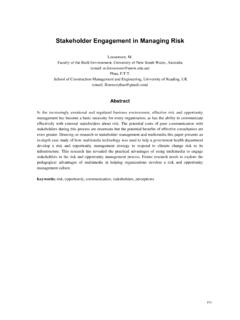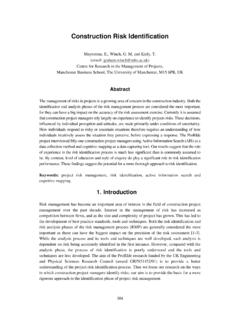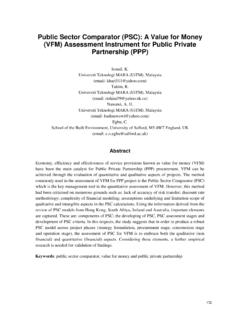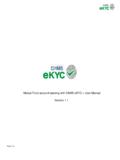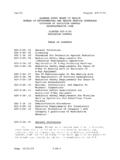Transcription of Customer Journey – a method to investigate user …
1 Customer Journey a method to investigate user experience Suvi Nenonen, Helsinki University of Technology Heidi Rasila, Helsinki University of Technology Juha-Matti Junnonen, Helsinki University of Technology Sami K rn , Helsinki University of Technology ABSTRACT Workplaces are stages for work experiences. There is a need to understand the experience as a definitive factor in workplace management. However the ways to investigate the experience are many and there are many perspectives to approach the methods . This paper aims to answer the question how to asses the work environments from the user perspective, as part of user experience ?
2 The methods for user orientated workplace management are presented. The conclusions indicate the different objects of different methods , which all together provide rich data for workplace management, user organisation and other stakeholders for the ones creating user experiences. KEYWORDS: Customer Journey , Work Environment, Usability, method INTRODUCTION We are entering or have already entered the experience economy (Pine and Gilmore 1997; LaSalle and Britton 2003). For the building owners and facility managers it is a challenge to understand how they, from their part, could create environments that enhance user experience .
3 Although the term " user experience " has been used extensively in recent years, it has been associated with a wide range of meanings (Forlizzy and Battarbee 2004). Unlike usability, user experience tends to include wider human experience dimensions (such as pleasure, fun, and other emotions) and also may have a temporal or longitudinal component. The Customer experience is a blend of company s physical performance and the emotional evoked, intuitively measured against Customer expectations across all the moments of contact (Shaw and Ivens 2002) While usability tends to be focused on task efficiency and effectiveness measures, user experience includes emotional and perceptual components across time.
4 The user experience consists of perceptions that shape emotions, thoughts, and attitudes. user experience involves a constant feedback loop repeated throughout the usage lifecycle including from initial discovery through purchase, out-of-box, usage, maintenance, upgrades, and disposal. (Beauregard et al. 2007) The concept of Customer satisfaction is outcome-oriented focusing mainly on functionality of the service/product. experience in contrast, is process-oriented including all the moment of contacts and emotions during the experience (Schmitt 1999). If user experience is the significant factor in designing, constructing, maintaining and developing work environments, one has to understand how to increase knowledge about user experiences in work environments.
5 It is essential to shift the focus from working processes towards employee experiences. The question arises: How to assess the work environments from the user experience perspective? To answer this question this paper proposes a methodology for assessing the experience as Customer Journey . The methodology is built in a gross-disciplinary manner: the post occupancy evaluations (Barrett and Baltry 2003), usability walk-through audits ( Nenonen and Nissinen 2005; Riihiaho 2002) and service process evaluations (Gummesson and Kingman-Brundage 1992) are combined with insight from Customer Journey (Christopher, Payne and Ballantyne 1991).
6 It is suggested that these analysis could enable to understand user s experiences, activities and factors, which are significant for the usability. POST OCCUPANCY EVALUATION, USABILITY WALKTHROUGH, CRITICAL INCIDENT TECHNIQUE AND Customer Journey Facility oriented approach Post Occupancy evaluation Post-Occupancy Evaluation - POE (Preiser et al. 1988) is the process of systematic collection of data on occupied built environments, analysis of these data and comparison with performance criteria. POE s are particularly aggravated to the users needs, preferences and experiences. It assesses how well buildings match users' needs, and identifies ways to improve building design, performance and fitness for purpose.
7 Building users are all people with an interest in a building - including staff, managers, customers or clients, visitors, owners, design and maintenance teams, and particular interest groups such as the disabled. It uses the direct, unmediated experiences of building users as the basis for evaluating how a building works for its intended use. POE is also a formal way of determining whether a recently occupied or remodeled building is performing as was intended in its programming and design (Horgen and Sheridan 1996). Post Occupancy Evaluation can be used for many purposes, including fine tuning new buildings, developing new facilities and managing problem buildings.
8 Organisations also find it valuable when establishing maintenance, replacement, purchasing or supply policies; preparing for refurbishment; or selecting accommodation for purchase or rent. (Preiser 1989.) Indicators for success of the building are for instance a high occupancy level, a positive appraisal by occupants and visitors, and easy to let (low vacancy rate, small number of movements). Indicators for failure are for instance complaints of users, negative comments of experts, high running costs or a burglary rate above average. Over the years there is a growing awareness of the importance of Total Building Performance Evaluation, also including technical aspects, building physics and costs (Preiser and Schramm 1998).
9 There are numerous methods of data-collection such as questionnaires, individual and group interviews, behavioural mapping, technical assessment tools and mathematical models, each with its own pros and cons. World-wide sound instruments such as the Real Estate Norm, Serviceability Tools and methods and other scaling techniques are used in order to measure functional aspects such as usefulness, accessibility, health, safety, and flexibility. (Voordt 1999) Some critics claim that such assessments concentrate too much on technical aspects of the buildings. It is focusing on building, giving feedback instead of feed-forward and needs additional methods to achieve the user .
10 (Alexander et al. 2005; Voordt 1999) Usability oriented approach Usability walkthrough A CIB Task Group 51 Usability of buildings has been created to apply concepts of usability, to provide a better understanding of the user experience of buildings and workplaces. Usability is defined as the ..effectiveness, efficiency and satisfaction with which a specified set of users can achieve a specified set of tasks in a particular environment According to this definition, a product s usability is determined by 3 key factors: Effectiveness whether users can achieve what they want to do with the product Efficiency how long it takes them to achieve it Satisfaction their feelings and attitude towards the product The first level of the usability decomposition is what is called usability attributes.



